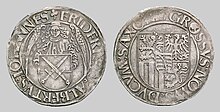Schreckberger


The Schreckenberger is a silver coin that was minted from 1498 to 1571. The large groschen were produced in the mints of Annaberg , Buchholz , Zwickau , Freiberg , Leipzig , Dresden and Saalfeld.
history
In 1491, a rich silver ore deposit was discovered on Schreckenberg near Annaberg-Buchholz . Five years later, the "Neustadt am Schreckenberg", later St. Annaberg, was founded as a planned urban complex. In 1498 the young mountain town was granted the right to mint coins. As a result, a mint was set up in the Sehmatal, but it was moved to Annaberg as early as 1502.
The coins minted in Annaberg are silver coins with a weight of approx. 4.5 g and a fineness of 93.3% (933/1000 fine). From 1558, coins weighing around 5 g with a fineness of 90.8% (908/1000 fine) were minted. The name of the pieces is derived from the Schreckenberg, from whose silver the coins were minted at the beginning of the minting period. On the front is an angel holding the Saxon Kurschild with the crossed swords. That is why the coins were also referred to as angel eggs . The name Mühlstein was also popular , as the mint may have been in the Frohnauer Obermühle in the beginning. The coat of arms of the Saxon dukes is on the back.

The Schreckenbergers had a high value due to their fineness. This is where the saying comes from: If you are a rich Annaberg, you have a sack full of Schreckenberger . At the beginning of the minting, the coin had a value of three interest groschen (= 36 pfennigs ). Seven Schreckenbergers had a face value of one gold gulden or from 1500 of one thaler (at that time still called guldengroschen and gulden). The minting of the Schreckenberger was stopped in 1571.
During the Kipper and Wipper era , a similar coin of the same name was minted in Saxony and other German states. In Thuringia, in the Gotha Mint and in the Weimar Mint, among other things, a Dreibätzner was minted into a Schreckenberger. She had a face value of four groschen (= 12 cruisers ). The fineness was only 37% (370/1000 fine) or even lower. The coins produced in large quantities with a silver content below the face value favored inflation during the Thirty Years' War . The coin, also known as the Kipper-Schreckenberger, became a symbol and epitome of a bad and inferior coin.
See also
- Kippertaler # Kippertaler to 60 Groschen - The coin image of the Schreckenberger on the Kippertaler should make the inferior coin popular.
- Saxon coin history # horn groschen, beard groschen, interest groschen, Schreckenberger
literature
- Helmut Kahnt, Bernd Knorr: Old measures, coins and weights. VEB Bibliographisches Institut, Leipzig 1986, ISBN 3-323-00013-7 .
- Walter Haupt: Sächsische Münzkunde , Berlin 1974
- Paul Arnold: Elector August (1553–1586) and the Saxon coinage. In: Numismatic Hefte No. 20, Dresden, 1986
- Paul Arnold: Walter Haupt and his "Sächsische Münzkunde". In Numismatic Issues No. 20, Dresden 1986
- Julius Erbstein , Albert Erbstein : Discussions in the field of the Saxon coin and medal history when listing the Hofrath Engelhardt's collection. Dresden 1888
- Gerhard Krug: The Meissnian Saxon Groschen 1338–1500 , Berlin 1974
